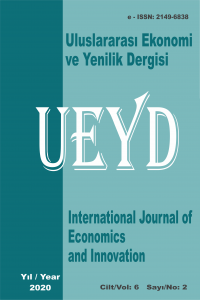Research Article
Year 2020,
Volume: 6 Issue: 2, 211 - 223, 17.10.2019
Abstract
Bu çalışmanın temel amacı iktisadi büyüme-yolsuzluk ilişkisini Türkiye’de 1995-2018 dönemi için sınır testi yaklaşımıyla araştırmaktır. Çalışmadan elde edilen bulgular şöyle sıralanabilir; (a) açıklayıcı değişkenlerin durağanlık özellikleri I(1) ve I(0) olmak üzere karışıktır, (b) sınır testi sonuçlarına göre kişi başı yatırımlar, kişi başı hane halkı tüketim harcamaları ve ticari açıklık iktisadi büyümeyi pozitif etkilemektedir, (c) diğer taraftan yolsuzluk, enflasyon ve iktisadi büyüme arasında istatistiksel olarak anlamlı bir ilişki yoktur. Bu bağlamda Türkiye ekonomisinde yolsuzluk iktisadi büyüme sürecini etkilememekle beraber ne “tekerdeki kum” nede “tekerdeki yağ”’dır.
Keywords
References
- Acaravcı, A., Akalin, G., & Erdoğan, S. (2019). Araştırma-Geliştirme Harcamalarının Türkiye İhracatına Etkileri. Hacettepe Üniversitesi İktisadi ve İdari Bilimler Fakültesi Dergisi, 37(1), 1-16.
- Akçay, S. (2002). Corroption and Ekonomic Growth: A Cross National Study. Ankara Üniversitesi SBF Dergisi, 57(01).
- Altunç, Ö. F., & Yıldırım, A. (2017). Yolsuzluğun ekonomik büyümeyi etkileme kanalları: Ülkeler arası bir çalışma. Akademik Sosyal Araştırmalar Dergisi, 5(63), 15-27.
- Arslan, Ü., & Sağlam, Y. (2011). The relationship between corruption and public investment: The case of Turkey. Çukurova Üniversitesi Sosyal Bilimler Enstitüsü Dergisi, 20(2), 365-378.
- Beşel, F., & Savaşan, F. (2014). Türkiye'de Yapısal Kırılmalar Altında Yolsuzluk‐Ekonomik Büyüme İlişkisi. Kocaeli Üniversitesi Sosyal Bilimler Dergisi, (27), 73-86.
- Cieślik, A., & Goczek, Ł. (2018). Control of corruption, international investment, and economic growth–Evidence from panel data. World Development, 103, 323-335.
- Del Monte, A., & Papagni, E. (2001). Public expenditure, corruption, and economic growth: the case of Italy. European journal of political economy, 17(1), 1-16.
- Dickey, D. A., & Fuller, W. A. (1981). Likelihood ratio statistics for autoregressive time series with a unit root. Econometrica: journal of the Econometric Society, 1057-1072.
- Dreher, A., & Gassebner, M. (2013). Greasing the wheels? The impact of regulations and corruption on firm entry. Public Choice, 155(3-4), 413-432.
- Drury, A. C., Krieckhaus, J., & Lusztig, M. (2006). Corruption, democracy, and economic growth. International political science review, 27(2), 121-136.
- Ehrlich, I., & Lui, F. T. (1999). Bureaucratic corruption and endogenous economic growth. Journal of Political Economy, 107(S6), S270-S293.
- Enders, W. (2014), Applied Econometric Time Series, 4. Baskı, USA: John Wiley&Sons, Inc.
- Yılmaz, Ö., Akıncı, M., & Erkal, G. (2014). Yolsuzluk ve İktisadi Büyüme ilişkisi: OECD ve AB Ülkeleri üzerine Panel Sınır Testi Analizi. Sayıştay Dergisi, 143-162.
- Gökalp, F. M. & Baldemir, E. (2006). Kurumsal Yapı ve Ekonomik Büyüme İlişkisi. Dokuz Eylül Üniversitesi Sosyal Bilimler Enstitüsü Dergisi, 8(1): 212-226.
- Huntington, S. (1968). Political order in changing societies. New Haven: Yale University Press.
- Karagöz, K., & Karagöz, M. (2010). Yolsuzluk, ekonomik büyüme ve kamu harcamaları: Türkiye için ampirik bir analiz. Sayıştay Dergisi, 76(1-3), 5-22.
- Kaufmann, D., & Wei, S. J. (1999). Does" grease money" speed up the wheels of commerce? (No. w7093). National bureau of economic research.
- Kwiatkowski, D., Phillips, P. C., Schmidt, P., & Shin, Y. (1992). Testing the null hypothesis of stationarity against the alternative of a unit root. Journal of econometrics, 54(1-3), 159-178.
- Johnson, S. (2018). Corruption is costing the global economy $3.6 trillion dollars every year. https://www.weforum.org/agenda/2018/12/the-global-economy-loses-3-6-trillion-to-corruption-each-year-says-u-n (Erişim Tarihi: 24.09.2019).
- Mauro, P. (1995). Corruption and growth. The quarterly journal of economics, 110(3), 681-712.
- Narayan, P. K. (2005). The saving and investment nexus for China: evidence from cointegration tests. Applied economics, 37(17), 1979-1990.
- Ozturk, I., & Acaravci, A. (2013). The long-run and causal analysis of energy, growth, openness and financial development on carbon emissions in Turkey. Energy Economics, 36, 262-267.
- Pesaran, M. H., & Shin, Y. (1998). An autoregressive distributed-lag modelling approach to cointegration analysis. Econometric Society Monographs, 31, 371-413.
- Pesaran, M. H., Shin, Y., & Smith, R. J. (2001). Bounds testing approaches to the analysis of level relationships. Journal of applied econometrics, 16(3), 289-326.
- Sharma, C., & Mitra, A. (2019). Corruption and Economic Growth: Some New Empirical Evidence from a Global Sample. Journal of International Development, 31(8), 691-719.
- Shleifer, A., & Vishny, R. W. (1993). Corruption, the quarterly journal of economics, 599-617.
- Sofuoğlu, E., Kızılkaya, O., & Ay, A. (2017). Yolsuzluk ve Ekonomik Büyüme Arasındaki İlişki: Yeni Sanayileşmiş Ülkeler için Panel Veri Analizi. International Conference On Eurasıan Economies. 2017: 476-482.
- Swaleheen, M. (2011). Economic growth with endogenous corruption: an empirical study. Public Choice, 146(1-2), 23-41.
- Transparency International (2017). People and Corruption: Citizen's Voices From Around The World. https://www.transparency.org/whatwedo/publication/people_and_corruption_citizens_ voices_from_around_the_world (Erişim Tarihi: 24.09.2019)
- Transparency International (2019a). What is corruption. https://www.transparency.org/what-is-corruption. (Erişim Tarihi: 25.08.2019).
- Transparency International (2019b). Corruption Perception Index. https://www.transparency.org/research/cpi/overview. (Erişim Tarihi: 27.09.2019)
- United Nations (2018). Global Cost of Corruption at Least 5 Per Cent of World Gross Domestic Product, Secretary-General Tells Security Council, Citing World Economic Forum Data. https://www.un.org/press/en/2018/sc13493.doc.htm (Erişim Tarihi: 24.09.2019)
- Wei, S. J. (1999). Corruption in economic development: Beneficial grease, minor annoyance, or major obstacle?. The World Bank.
- World Bank (1997). Helping countries combat corruption: The role of the World Bank. http://www1.worldbank.org/publicsector/anticorrupt/corruptn/corrptn.pdf. (Erişim Tarihi: 25.08.2019).
- World Bank (2019). World Development Indicators. https://databank.worldbank.org/source/world-development-indicators (Erişim Tarihi: 26.09.2019)
There are 35 citations in total.
Details
| Primary Language | Turkish |
|---|---|
| Subjects | Economics |
| Journal Section | Research Articles |
| Authors | |
| Publication Date | October 17, 2019 |
| Submission Date | February 28, 2020 |
| Published in Issue | Year 2020 Volume: 6 Issue: 2 |
Cited By
Gelir ve Servet Vergileri Türkiye'de Gelir Dağılımını Etkilemekte midir?
Anemon Muş Alparslan Üniversitesi Sosyal Bilimler Dergisi
Güray AKALİN
https://doi.org/10.18506/anemon.851634
SEÇİLİ ARAP ÜLKELERİNDE ALGILANAN YOLSUZLUK
R&S - Research Studies Anatolia Journal
https://doi.org/10.33723/rs.1082924
TÜRK KAMU PERSONELİ GÖZÜNDEN YOLSUZLUK: NEDENLERİ, ETKİLERİ, SONUÇLARI VE ALINABİLECEK TEDBİRLER ÜZERİNE NİTEL BİR ARAŞTIRMA
Uluslararası İktisadi ve İdari İncelemeler Dergisi
https://doi.org/10.18092/ulikidince.1606141
International Journal of Economics and Innovation
Karadeniz Technical University, Department of Economics, 61080, Trabzon/Türkiye
This work is licensed under a Creative Commons Attribution 4.0 International License.

